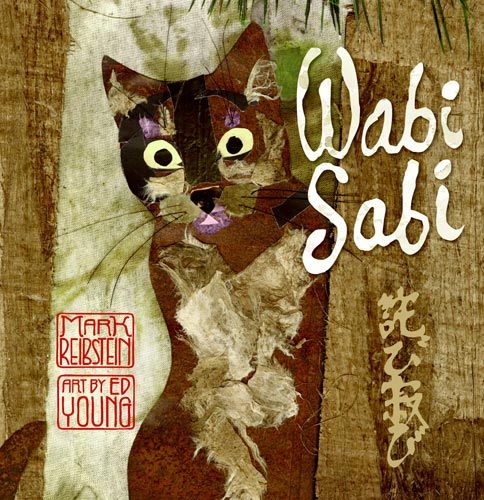Blogger Graphics
Wabi Sabi
By: Mark Reibstein
Illustrated By: Ed Young
Publisher: Little Brown and Company Hatchette Book Group USA
Copyright: 2008
Genre: Fiction Japanese Poetry
Grade Level: 3rd or 4th
Brief Synopsis: A cat named Wabi Sabi lives with her master in Kyoto, Japan. The story begins when her master is asked what the name Wabi Sabi means. Her master answered, “That is hard to answer.” After this Wabi Sabi decided to venture off on an adventure to find out the true meaning of her name. This story is written with a haiku on every page along with regular text.
About the Author:
 Mark Reibstein- he is an English teacher and writer who has lived in New York, California, Hawaii, Japan, and Thailand. While living in Kyoto, Japan he met a cat named Wabi Sabi and was close friends with her for 10 years. This clearly is his inspiration for this story, and he was able to take something from his life and give them their own adventure. Mark and his daughter now live near San Fransisco with good friend Arlo, also a cat.
Mark Reibstein- he is an English teacher and writer who has lived in New York, California, Hawaii, Japan, and Thailand. While living in Kyoto, Japan he met a cat named Wabi Sabi and was close friends with her for 10 years. This clearly is his inspiration for this story, and he was able to take something from his life and give them their own adventure. Mark and his daughter now live near San Fransisco with good friend Arlo, also a cat.  Ed Young- Ed Young, winner of the 1990 Caldecott Medal, has illustrated over 40 books for children, four of which he has also written. Ed Young was born in Tienstin, China. He grew up in Shanghai and later moved to Hong Kong. He came to the United States as a young man on a student visa. A graduate of the Los Angeles Art Center, Young has since taught at the Pratt Institute, Yale University, Naropa Institute, and the University of California at Santa Cruz. He currently lives with his wife in Hastings-on-Hudson, New York. When he was young he thought he could “disappear” into his own world. He brought his own drawings to life.
Ed Young- Ed Young, winner of the 1990 Caldecott Medal, has illustrated over 40 books for children, four of which he has also written. Ed Young was born in Tienstin, China. He grew up in Shanghai and later moved to Hong Kong. He came to the United States as a young man on a student visa. A graduate of the Los Angeles Art Center, Young has since taught at the Pratt Institute, Yale University, Naropa Institute, and the University of California at Santa Cruz. He currently lives with his wife in Hastings-on-Hudson, New York. When he was young he thought he could “disappear” into his own world. He brought his own drawings to life. Themes: Finding the real beauty around you
Learning the haiku writing style
Exploring your surroundings
Beauty found in nature
Pre-Reading Activities:
-Introduce Haikus to the class with a mini-lesson as a whole group. Come up with a class Haiku using the school environment for inspiration.
-Have the students look up the meaning of their own name using the internet, and create a visual definition by writing their name with pictures around it that explain the meaning. This will lead into the story when Wabi Sabi tries to find the meaning of his name.
-So a picture walk through the story Wabi Sabi with the class. Ask them for predictions and opinions about what they see in the illustrations. Ask them why they think the illustrator decided to use things in nature to create the settings and characters in the book. Post Reading Activities:
-Students will write their own Haiku. I will give them the format of what to include in each line and they will pick their own topic.
First line 5 syllables
Second line 7 syllables
Third line 5 syllables
Haiku is written with details of the senses and of nature. A seasonal reference and transition are usually added into a Haiku.
-The students will take things from nature and create their own illustrations using Wabi Sabi’s illustrations as a model and guide. We will go outside to find things from nature to use in their illustrations. The students will then have to write a paragraph describing what they find simply beautiful about their creation.

Blogger Graphics
Reflection: Wabi Sabi comes alive through the illustrations on each page. This paired with the beautiful haiku written allows for the reader to completely visualize and come to understand the story’s meaning. This story can be used in multiple ways to introduce Japanese teachings and beliefs. This story teaches the student about the beauty that exists around them in the simple things. It can help them open their eyes to their surroundings, and not taking the little things for granted. It also demonstrates to the students the belief of Shintoism by many Japanese and their immense respect for nature. The Japanese Haiku writing throughout the book with translations at the end make the story authentic. I like this book because of its incredible potential in many areas of curriculum.
Links:
Mark Reibstein Bio.
Ed Young Bio.

No comments:
Post a Comment